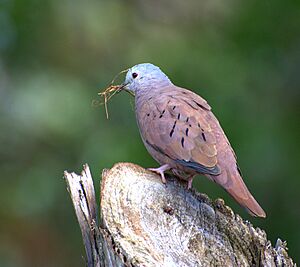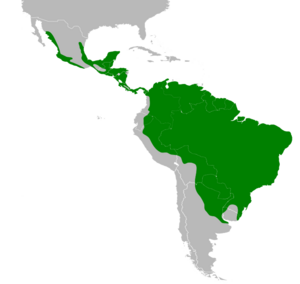Ruddy ground dove facts for kids
Quick facts for kids Ruddy ground dove |
|
|---|---|
 |
|
| Conservation status | |
| Scientific classification | |
| Genus: |
Columbina
|
| Species: |
talpacoti
|
 |
|
The ruddy ground dove (Columbina talpacoti) is a small, colorful bird found in warm parts of the New World. These doves live from Mexico all the way south to Brazil, Peru, Paraguay, and northern Argentina. You can also find them on the islands of Trinidad and Tobago. Sometimes, a few of these doves might even visit the southwestern United States, especially in winter.
These doves are very common in open areas like scrublands, farms, and even cities. They often eat grains alongside other birds like feral pigeons. They build a simple, cup-shaped nest out of sticks in trees. The female usually lays two white eggs. The eggs hatch in about 12 to 13 days, and the baby doves are ready to fly in another 12 to 14 days. Sometimes, a pair might have two or even three groups of babies in a year! However, many young doves don't survive because of predators or falling from the nest.
Ruddy ground doves fly very fast and straight. Their wings beat regularly, with a quick flick now and then, which is typical for pigeons.
Contents
What Does a Ruddy Ground Dove Look Like?
Ruddy ground doves are small birds with short tails. They are usually about 17 centimeters (6.7 inches) long and weigh around 47 grams (1.7 ounces).
- Males: Adult males have a light gray head and neck. Their upper body is a rich reddish-brown, with black spots on their wings. Their belly is a lighter brown, and their tail has black edges. When they fly, you can see their cinnamon and black feathers under their wings.
- Females: Females are mostly grayish-brown instead of reddish-brown. Their head and body colors don't stand out as much as they do on the males.
- Chicks: Young doves show hints of the colors of their parents.
Both male and female ruddy ground doves have a series of black spots on their wing feathers.
Different Types of Ruddy Ground Doves
There are four main types, or subspecies, of ruddy ground doves. They live in different parts of their wide range:
- Columbina talpacoti caucae lives in a valley in western Colombia.
- Columbina talpacoti eluta lives along the Pacific coast of Mexico.
- Columbina talpacoti rufipennis is found in Central and Eastern Mexico, Central America, Colombia, and northern Venezuela, including some islands.
- Columbina talpacoti talpacoti lives in eastern Ecuador, Peru, Guyana, Bolivia, Paraguay, Uruguay, northern Argentina, and Brazil. Sometimes, they visit central Chile.
Life Cycle and Reproduction
Ruddy ground dove pairs protect their nesting area from other doves. The male sings a soft, two-part cooing sound, repeating it for several seconds. Their nests are small bowls made of branches and sticks. They build them tightly hidden among vines or branches.
The female lays two eggs, and both parents take turns sitting on them for 11 to 13 days until they hatch. The baby doves leave the nest when they are only about two weeks old. If the weather is good, the parents might start a new nest just a couple of days later! They build nests in both short and tall trees. Sometimes, they even choose unusual spots like banana plants or gutters on houses.
Where Do Ruddy Ground Doves Live?
These doves are very good at living in places changed by humans. They like open areas. When forests are cut down, it helps them spread, especially into areas used for pastures or growing grains. They have even moved into big cities in Brazil.
Ruddy ground doves can be quite aggressive with each other, even though they sometimes gather in groups. They fight over food and protect their areas. Males are usually more aggressive. When they fight or sunbathe (lying on their side with a wing stretched up), they show off the large black feathers under their wings.
In some parts of the United States, people who watch birds have noticed that another type of dove, the Eared dove, is becoming more common than the ruddy ground dove in cities. This other dove seems to be better at living in urban areas.
Even with these changes, the friendly ruddy ground dove is still a common sight in backyards, parks, and gardens, even in big cities.
Gallery




